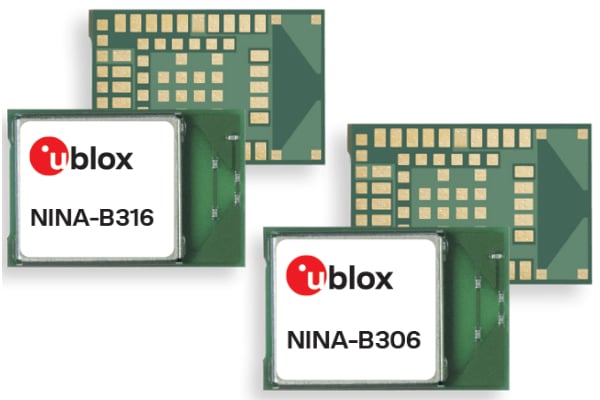u-blox Adds Devices with Internal Antennas to Series of Bluetooth 5 Communications Modules
Summary
u-blox sets its sights on printed antennas in small packages with the release of new BLE modules
The NINA-B306/316 modules are the newest members of the NINA-B3 series of stand-alone Bluetooth 5 low energy (BLE) modules. The new entrants each include a trapezoidal printed antenna, obviating the need for an external antenna. This feature allows designers to lower their overall system parts counts and to save both space and costs.
While the new units are designed largely with the Internet of Things (IoT) in mind, the NINA-B3 series as a whole is appropriate for the automotive and transport markets, as well as for healthcare and intelligent buildings.

The u-blox NINA-B306 and NINA-B316 modules
u-blox specializes in developing devices for positioning and wireless communications for the automotive, industrial, and consumer markets. The company offers a wide array of products utilizing Wi-Fi and Bluetooth for short-range networks as well as devices utilizing world-spanning cellular networks.
The new NINA-B306/316 modules are pin-for-pin compatible with the older members of the NINA-B3 series. They are also directly compatible with the extent software, providing a seamless pathway for OEMs looking to upgrade to the new modules.
All members of the NINA-B3, including the new NINA-B306/316 modules, can work with operating voltages from 1.7 V to 3.6 V, and will operate over a wide temperature range of –40 °C to +85 °C, making them suited to the tough, real-world environments often imposed by IoT operations. Package sizes vary from 10.0 mm x 11.6 mm x 2.2 mm up to 10.00 mm x 15.0 mm x 3.8 mm.
Bluetooth and the IoT
Bluetooth offers many advantages for implementation of IoT functionality, including its inherent low-energy consumption. Additionally, improvements in data rates and ranges, as well as its support for decentralized mesh networking are making Bluetooth technology the go-to choice for short-range communications.
Indeed, according to Pelle Svensson, Market Development Manager for Product Center Short Range Radio at u-blox, “The introduction of Bluetooth 5 makes the technology even more applicable to a range of IoT applications.” He goes on to state that “The NINA-B306/316 modules, with their fully integrated PCB antenna and global certification, make implementing this powerful technology even easier.”
Samples of the NINA-B306/316 are now available and full production is planned for March of 2019. Additionally, evaluation kits for many of the members of the NINA-B3 series are now available from u-blox.
Other Players in the Field
Today’s engineers have no time for reinventing the wheel, so devices that obviate the need to design and build wireless connectivity for each new product is a universal need. Not surprisingly, many organizations are offering products to meet this requirement. Here’s a small sampling:
- Telit offers a complete line of IoT modules utilizing both Wi-Fi and Bluetooth. The WL865E4-P offers both communication modes in the same package.

The WL865E4-P offers Wi-Fi and Bluetooth capabilities in the same module. Image used courtesy of Telit
- Texas Instruments offer a wide array of module-based wireless connectivity solutions. Its SimpleLink platform offers Bluetooth 5.0, Wi-Fi and Zigbee options. Its Bluetooth 5.0 modules features standby current requirements as low as 0.9µA.
Products such as these also greatly reduce the required expertise in wireless technology that an organization needs to bring a product to market, further reducing overall design and manufacturing costs.
Have you worked on a project that required Bluetooth connectivity? What Bluetooth modules do you have experience with? Let us know in the comments below.








I have experiences in using the Nordic BT5 development kit outside in ideal conditions. With the long range mode, we achieved a distance of 251 metres between two BT 5 devices. This is about 502 metres return. This is about 1,7 microseconds. Nordic told us that in this Spring 2017 version there was a ( spec ? ) bug in the time-out processing of signaling . If the signaling message response took more than 1,7 microseconds to return, the data link was not accomplished. I wonder if this spec bug has now been corrected ? We think the radio signal could have made more than 251 metres without this signaling feature.
Heh, so the u-blox module uses the Nordic nRF52840. I always though u-blox spin their own silicon